Adrian Collins's Blog, page 164
August 28, 2021
REVIEW: Bubbles in Space: Tropical Punch by S.C. Jensen
Bubbles in Space: Tropical Punch by S.C. Jensen is a cyberpunk detective novel that manages to somehow be both light hearted and entertaining while also dark as fuck. It’s really all about your attitude in the dystopian setting of HoloCity. A place where the vast majority of humans live in utter poverty, life is cheap, and death is free. It’s not quite grimdark but it’s not-not grimdark either, being a bit like Ciaphas Cain in the Warhammer 40K universe. The protagonist’s humorous and can-do attitude contrasts against an utterly crappy universe.
 The premise of Bubbles in Space: Tropical Punch is Bubbles Marlowe is a barely capable private investigator who royally screws up her most recent case. Hired to protect a young woman, she shows up just in time to see her decapitated. Then she sees an identical woman also meet her end. Bubbles almost dies herself but manages to escape and, through a lottery she didn’t enter, wins a ticket that puts her on a luxury space cruise. When she arrives, things get (somehow) even worse.
The premise of Bubbles in Space: Tropical Punch is Bubbles Marlowe is a barely capable private investigator who royally screws up her most recent case. Hired to protect a young woman, she shows up just in time to see her decapitated. Then she sees an identical woman also meet her end. Bubbles almost dies herself but manages to escape and, through a lottery she didn’t enter, wins a ticket that puts her on a luxury space cruise. When she arrives, things get (somehow) even worse.
Bubble is a recovering alcoholic who lost her arm due to the Chief of Police in HoloCity ordering a hit on her for not dropping a case. Now equipped with a new cybernetic arm, one she’s disappointed doesn’t give her super strength, she’s upset the Chief of Police still considers her a loose end. She has no interest in actually solving the cases she’s presented but just wants to enjoy a brief respite from people trying to kill her.
I absolutely loved Bubbles in Space: Tropical Punch from beginning to end. There’s a weird and wacky supporting cast with such oddballs as Hammet the SmartPet pig that serves as Bubbles’ best friend, Cosmo the billionaire makeup magnate that acts like a rock star, and Rae the cerulean haired scientist who just wants to do Bubbles a favor only to bitterly come to regret it. I also loved the villains that include the aforementioned corrupt police chief and a luddite cult with a secret.
The combination of film noir and literary detective stories with cyberpunk is something that has always worked together well, starting with Blade Runner and having many other variations throughout the years. Bubbles is a lot closer to the fedora and trench coat type despite the fact she has attire utterly disimilar. S.C. Jensen even incorporates a bunch of 20s, 30s, and 40s slang modified to be futuristic. It makes the setting subtly “off” from modern parlace.
The best part of Bubbles in Space: Tropical Punch is definitely the space cruise section as poor Bubbles is shown to be utterly bamboozled by the life of the super-rich. The luxuries available to them while she just wants to be able to keep the lights on and eat is a source of much subtle social commentary. Bubbles is also not particularly welcomed by the chief of security and Admiral for the space liner fleet. Which is perfectly expected for a fugitive that isn’t actually rich but on someone else’s charity.
Bubbles in Space: Tropical Punch is a great indie cyberpunk novel and one I strongly recommend. The characters are extremely entertaining, the comedy is on point, the world-building is well-done, and the action is good. I picked up the next volumes in the series immediately after and hope to read the entire series.
Read Bubbles in Space: Tropical Punch by S.C. Jensen
The post REVIEW: Bubbles in Space: Tropical Punch by S.C. Jensen appeared first on Grimdark Magazine.
August 27, 2021
REVIEW: Legacy of Light by Matthew Ward
Matthew Ward’s Legacy series reaches its brutal conclusion in Legacy of Light. A book of personal, moral, and physical attrition, Legacy of Light continues the story of the Tressian republic and the Hadari empire, the lands of mists and forests and the gods and entities that live in them, and a group of heroes dragging their people and friends to safety in a range of very different directions.
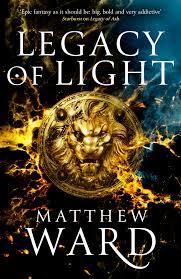 As book three in the Legacy series, it goes without saying that if you haven’t started this series, you’d probably be a bit silly to continue on with this review. Best you click here and head to our review of Legacy of Ash.
As book three in the Legacy series, it goes without saying that if you haven’t started this series, you’d probably be a bit silly to continue on with this review. Best you click here and head to our review of Legacy of Ash.
In Legacy of Light Viktor and Rosa join forces, cross the border into the Hadari empire and go looking for something in the dark remnants of a dead queen’s city. A surprise visit from the Raven lets Rosa know that Viktor might be making a mistake that will destroy the world. But can you really trust the Raven, even if he loves you?
Altiris is a member of Lord Josiri Trelan’s hearthguard. A wine and some fallen aristocratic company wanting to use his station to get back ahead find him face-to-face with the resurgence of an old foe of Tressia returned from the mists. Viktor’s prizes from the Hadari empire stolen and an old face Altiris knows he has to hunt down, is this the opportunity for glowing heroism Altiris has been waiting for?
Josiri is starting to see a sadness in his porcelain goddess partner, Ana. Her sarcasm and sardonic humour is slowly changing to despair, a clear reflection of the crushing of hope Ward has delivered throughout this series. With Tressia being controlled by Viktor, who has become Lord Protector, and Josiri now a member of a council not needed to meet Tressia’s needs, he leads the constabulary, men and women whose roles are being slowly usurped by the militant Drazina.
A year after crossing the Hadari border with Viktor, Rosa is trying to diffuse her anger and disappointment in Viktor by creating statues to hammer out her her feelings. Only, a favour gets called in and she’s off to the Eastshires to try to diffuse a growing resentment at inaction to free those Tressians and the land sacrificed to the Hadari for peace. Drenn, wolfshead, is the one stirring them up. Is Drenn enough to stir up a new flame in Rosa?
Melanna is now both Empress and mother, leader of the Hadari. With an old angered god now chasing her five year old daughter as he once chased her, and the Golden Court of the Hadari empire assembling with all the political intrigue and danger that brings, Melanna is in a tough position, but being supported by an odd friend she just might make this work. But surviving her own people might be harder than obtaining the throne in the first place.
With the character threads mentioned above the key ones in my eyes, and not even half the POVs, Legacy of Light is epic on a Sanderson / Gwynne scale. It’s big, it’s bold, and the feeling of attrition I mentioned in my review of Legacy of Steel is just suffocating. The world is hurting, both Tressia and the Hadari empire are running out of warm bodies to put in their shield walls, and we the reader hurt and feel drained with the story and it’s characters.
To me, this was a book about Josiri and Victor, and the paths that life leads these two on as they try to save Tressia. The people they use up and destroy. The bodies their goals and morals leave behind. The relationships and friendships and family ties twisted and burned and lost. And this is where the true excellence of this novel lies—not in the Serathi, sweeping battles, mists (and horrors within), and terrifying assassins—but in what we do to each other to achieve our ends. In this, Legacy of Light is just beautifully written.
Were I to critique one aspect of Legacy of Light, it would be that so strong is the impact of Josiri and Victor, that I was found a bit wanting on Sidara in the second half of the book, and Rosa throughout. But I feel it had to be this way for the ending to truly land.
And what an ending. I may be a 100kg 2m tall hairy bloke but I’ll be damned if I didn’t choke up for the last three chapters. The sense of loss, sadness, and a glimmer of hope only witnessed by the remaining few survivors had tears in my stubble. It reminded me a lot of the end of Lord of the Rings—just a huge relief mixed with intense sadness. Having finished the book at midnight last night, I must have laid under the blanket staring at the wall for an hour, just letting that last couple of hours’ reading percolate.
In Legacy of Light Matthew Ward has delivered such an ending to his colossal trilogy that I may need a few days away from books just to let this feeling allow me to kick something else off without bias. Epic, exhausting, brutal, and magnificent, Legacy of Light was pretty much everything I hoped it would be when I opened the front cover. With his first full trilogy out of the way, bring on whatever Matthew Ward publishes next.
Read Legacy of Light by Matthew Ward
The post REVIEW: Legacy of Light by Matthew Ward appeared first on Grimdark Magazine.
August 26, 2021
REVIEW: Game of Thrones S1
Released ten years ago, Game of Thrones S1 was a game-changer for grimdark on TV. Based on George RR Martin’s award winning 1996 start to A Song of Ice and Fire, Game of Thrones S1 followed a disruptive period in Westeros as one death sets in motion a tale full of political intrigue, magic, dragons, bloody battles, and fights for power and survival.
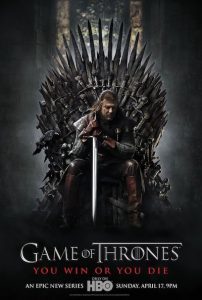 Game of Thrones S1 opens strong. Frightened rangers encounter terrifying White Walkers to provide the overarching threat that runs throughout the show and we get a glimpse of Ned Stark’s stubborn and honourable ways as he beheads a deserter from the Night Watch. Following the death of the Hand of the King, Ned’s comfortable life with his family and the people of Winterfell is thrown into turmoil as his old friend, the constantly drunk and foul-tempered King Robert Baratheon, drags him from Winterfell and commands him to rule as the new Hand of the King down in the warmer and much more complex region of King’s Landing. Ned Stark finds himself caught in a web of political chaos as he is surrounded by crooked Lords, devious council members, and ambitious families all wanting their own slice of power.
Game of Thrones S1 opens strong. Frightened rangers encounter terrifying White Walkers to provide the overarching threat that runs throughout the show and we get a glimpse of Ned Stark’s stubborn and honourable ways as he beheads a deserter from the Night Watch. Following the death of the Hand of the King, Ned’s comfortable life with his family and the people of Winterfell is thrown into turmoil as his old friend, the constantly drunk and foul-tempered King Robert Baratheon, drags him from Winterfell and commands him to rule as the new Hand of the King down in the warmer and much more complex region of King’s Landing. Ned Stark finds himself caught in a web of political chaos as he is surrounded by crooked Lords, devious council members, and ambitious families all wanting their own slice of power.
Ned Stark is the heart of Game of Thrones S1. The always brilliant Sean Bean (Lord of the Rings, Equilibrium, Sharpe, Troy) loses himself in the role as the weary leader doing his best to mop up the mess that those around him seem so intent on causing. Burdened by his sense of honour whilst wanting to be anywhere but in King’s Landing, he provides a sane, relatable pair of eyes as we witness the madness and chaos of the capital city. He despairs at the drunken, rude state of his king and old friend and watches with suspicion as the magnificently devious Queen Cersei plots her own rise to power along with that of her Lannister family. Sold by HBO as “Lord of the Rings meets The Sopranos”, Game of Thrones S1 has all the brilliant fantasy of Lord of the Rings mixed with the backstabbing and excellent dialogue of The Sopranos. The series handles the numerous characters and settings with ease, characters such as Cersei, Tyrion, Danaerys, Jon Snow, and more all feel as though they are given their time to shine on screen and create must-watch-TV. It is paced well with each episode ending with that urge to put the next one on straight away.
Game of Thrones S1 is filled with memorable moments and characters and is suitable for lovers of fantasy and those who have often turned away from the genre. There is a beauty in the philosophical speech of the Imp, Tyrion in Cripples, Bastards, and Broken Things, a sickening satisfaction as the dastardly Viserys finally receives A Golden Crown, devastation and shock at a beheading in penultimate episode Baelor, and the sheer triumph of the fiery finale Fire and Blood. Each of the ten episodes are memorable and powerful with sharp dialogue and beautiful cinematography all brought together by one of the strongest casts ever seen in a TV series. Game of Thrones S1 brings grimdark to the masses and it is just the start of an epic adventure full of shocking deaths and some of the most memorable moments in TV history. Game of Thrones S1 is the perfect introduction to George RR Martin’s world – as Cersei herself says to Ned, “When you play the game of thrones, you win or you die. There is no middle ground.”
The post REVIEW: Game of Thrones S1 appeared first on Grimdark Magazine.
REVIEW: The Witcher: Nightmare of the Wolf
The Witcher: Nightmare of the Wolf is the first attempt from Netflix to flesh out the world of the Continent introduced in the Henry Cavill led series from 2019. The anime prequel follows the adventures of Vesemir, the mentor to Cavill’s Geralt of Rivia and a character who is set to play an important role in the upcoming second season of the live-action show.
The Witcher: Nightmare of the Wolf allows Netflix to introduce Vesemir, a character known to fans of Andrzej Sapkowski’s The Witcher novels and the insanely popular games including Game of the Year winner The Witcher 3: Wild Hunt. Monsters stalk the roads and pounce on unfortunate passers-by, ripping apart bodies in a bloody and gory fashion. A young and confident Vesemir arrives and uses his enhanced powers as a Witcher (a human who has been conditioned and mutated into a monster slayer with heightened senses and strength) to take down the monster. Leaving a young boy in the cold forest, we see that Vesemir is not exactly the dashing hero we expect from stories. He kills for coin and treats monster slaying as a job and not a calling. Caught in a web of lies and betrayal, Vesemir searches for answers and as he heads off towards an old elven stronghold on the trail of a violent leshen.
The Witcher: Nightmare of the Wolf jumps between Vesemir as an arrogant and powerful witcher tracking down monsters and Vesemir as a young, poor boy dreaming of a better life. Viewers gain an understanding of his character as he flees his home in the hope of a better life following the arrival of Deglan, an experienced and hardy witcher. Vesemir is unique in that he chooses to become a witcher, facing the dangerous trials and tribulations along the way. He befriends the young boys taken as payment and forced into the life that he has chosen and proves his strength and determination. Through it all, we see the distrust humans and mages have of the witchers who hunt monsters for them. In fact, many view them as no better than the monsters they hunt and this creates tension in the kingdom where Vesemir trains in Kaer Morhen. The Witcher: Nightmare of the Wolf drops hints and easter eggs for the hardcore Witcher fans but also gives enough of a fast-paced and interesting tale of a man caught between what is right and what is easy, to pull in the casual viewer. The animation is excellent and the anime style allows for Sapkowski’s world to come alive with fountains of blood and magnificent blasts of magic that the live-action show has yet to produce.
The Witcher: Nightmare of the Wolf is an interesting and bloody addition to The Witcher world that offers a prequel that will whet the appetite of those waiting for the second season of The Witcher. The Witcher: Nightmare of the Wolf fills in some of the blanks of the live-action show and expands the world of the Continent in a violent and bloody way that will entertain those with a strong stomach. It introduces viewers to one of the more interesting characters in the world and leaves the audience waiting for more. A violent, slick, and enjoyable fantasy anime that will leave fans of The Witcher screaming like wraiths as they eagerly wait for the live-action entrance of Vesemir.
The post REVIEW: The Witcher: Nightmare of the Wolf appeared first on Grimdark Magazine.
August 24, 2021
Review: Roadside Picnic by Arkady and Boris Strugatsky
Brothers Arkady and Boris Strugatsky came up with the idea of Roadside Picnic in Komorovo, a Russian town about an hour from St. Petersburg, in 1970. The brothers wrote the story in 1971, and while it was published in sections beginning in 1972, it took them 8 years to finally have the story published in book form after a lengthy battle with soviet censorship. Roadside Picnic is their most well-known work and has been published in more than 20 countries.
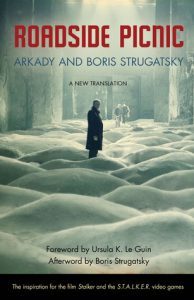 The premise of Roadside Picnic is brilliantly simple. It is a story about the aftermath of humanity’s first contact with alien life. Shortly before the story begins, aliens visit the earth, stay for a short time, then depart as suddenly as they’d arrived. What they leave behind are mysterious Zones, areas filled with invaluable technological wonders. But these areas are also filled with bizarre traps and dangers that can be instantly and brutally fatal.
The premise of Roadside Picnic is brilliantly simple. It is a story about the aftermath of humanity’s first contact with alien life. Shortly before the story begins, aliens visit the earth, stay for a short time, then depart as suddenly as they’d arrived. What they leave behind are mysterious Zones, areas filled with invaluable technological wonders. But these areas are also filled with bizarre traps and dangers that can be instantly and brutally fatal.
Those who venture into these areas are known as stalkers (Roadside Picnic served as the inspiration for the 1979 film Stalker, as well as the S.T.A.L.K.E.R. series of video games). It was the novel concept of deadly areas filled with priceless alien technology that drew me to the book, but it was anti-hero protagonist Red Schuhart’s personal journey that kept the plot moving. Even as Red’s world became increasingly jaded, Red remained a defiant non-conformist. A volatile and occasionally violent alcoholic, Red was devoted to his wife and daughter, someone who would reflexively jeopardize himself to protect an enemy then flick ashes onto his carpet.
There’s something both fascinating and terrifying about ineffable alien beings. Creatures whose minds are so incomprehensible that understanding them is like trying to visualize a fourth dimension. That Lovecraftian feeling of human insignificance is pervasive throughout Roadside Picnic. The Zones are places that follow no human logic or any natural laws of this planet. For example, there are random spots of incredibly high gravity that will crush flat anything that crosses their threshold. Humanity’s insignificance is further emphasized by the fact that even after years of study, our finest minds are unable to understand, let alone reverse engineer any of the artifacts found in Zones.
Roadside Picnic maintains a brisk and energetic pace throughout. I never felt safe in the world of the Zone, and that made it a real page turner. It never takes itself too seriously, and at around 200 pages, it doesn’t wear out its welcome. Roadside Picnic is a great read, especially for anyone looking for a different flavor of post-apocalyptic world. It would sit comfortably next to Dmitry Glukhovsky’s Metro 2033 on a bookshelf, like a fun and zippy roadster parked next to a big black SUV.
Read Roadside Picnic by Arkady and Boris Strugatsky
The post Review: Roadside Picnic by Arkady and Boris Strugatsky appeared first on Grimdark Magazine.
August 23, 2021
REVIEW: Watch_Dogs Legion
Watch_Dogs: Legion is a video game that takes the franchise into a dystopian post-Brexit vision of London. An oppressive authoritarian PMC, Albion, has taken over the country and divided the public services of the country among its corporate allies. Choosing from a bunch of randomly generated NPCs, you create an army to do battle with this corporatocracy and liberate the city from their control.
 The game starts with a terrorist attack on an after-hours Parliament carried out by unknown forces that hacktivist group DeadSec is attempting to prevent. They don’t do so well due to a mysterious hacker named Zero Day. Rather than a liberating rallying cry of the oppressed, as in V for Vendetta, this attack results in Albion justifying its takeover. DeadSec is gutted and it falls on the player to rebuild them a year later.
The game starts with a terrorist attack on an after-hours Parliament carried out by unknown forces that hacktivist group DeadSec is attempting to prevent. They don’t do so well due to a mysterious hacker named Zero Day. Rather than a liberating rallying cry of the oppressed, as in V for Vendetta, this attack results in Albion justifying its takeover. DeadSec is gutted and it falls on the player to rebuild them a year later.
The original Watch_Dogs was a present-day cyberpunk game that dealt with organized crime, human trafficking, guilt, and hypocrisy but had a divisive reception among gamers. Watch_Dogs 2 overcompensated with its bright and humorous hacktivist adventure in San Francisco. The enemies there were primarily white-collar criminals and the stakes felt incredibly low except for one mission chain that killed a major character seemed to avert that feeling.
This game attempts to bridge the gap between the dark and brooding content of the original game with its wackier sequel. Not always to great effect. Albion is an enemy with actual teeth and allied with murderous criminals that routinely show how vile they are in ways ranging from believable to puppy-kicking evil.
The developers go overboard a little bit by having Albion regularly shooting people in the street and brainwashing people but herding immigrants into a monstrous shantytown as well as gutting the National Health Service are all-too-believable. Either way, the story at least feels like there’s stakes unlike Watch_Dogs 2. Despite Ubisoft’s ridiculous claims to be apolitical in all things, this is a game developer that cut its teeth on Tom Clancy’s IP after all, it has some decent social satire among the dross like its handling of homelessness.
Unfortunately, the narrative is undermined by the randomly generated protagonists being people you can’t really invest in. Aiden Pearce may have been divisive but at least he cared about things and Marcus Halloway had an easy-going charisma. Almost all of the NPCs have extremely weak voice acting and they have the same dialogue anyway, so it falls upon the rest of the cast like Sabine or sarcastically fun AI Bagley to do the narrative heavy lifting. There’s a fix for that but it requires shelling out more money (see below).
The game is also gutted of many features that made the previous ones really entertaining. Previously you could engage in SWATing with the police or gang members. You could also change traffic lights, blow up steam pipes, as well as shut down the power in areas. You could even do bullet-time murder sprees. You have significantly fewer abilities this time around and even with Tech Points don’t have the broad level of tricks that made the previous game so much fun. There’s the flying cargo drone for some of them that’s a lot of fun but it’s a poor compensation for all the lost content.
The recruit-anyone mechanic is entertaining to play with but also undermines the narrative as a popular uprising. A fascist regime like Albion’s is going to have the approval of at least some of the people, particularly the racist and authoritarian kind, so at least some of the people should be off-limits no matter what you do. This is just poor game design even if there at least a decent chunk of the populace who are anti-DeadSec. It doesn’t help that the randomly generated thing may result in some weird ages and voice choices. The latter is especially notable as its quite clear not everyone is a Native Londoner in the acting or remotely able to imitate it.
The best way to fix a lot of the game’s problems is via the power of buying, though. If you purchase the Season Pass or the Bloodline DLC and characters separately, you can remove a lot of the game’s weaknesses. The Bloodline DLC is a decent-sized prequel that has you play Aiden Pearce and Wrench (from WD2) as you fight against a French arms dealer that wants to kill them both. It’s the best writing in the game and manages to make Aiden a more interesting character by highlighting his flaws as well as hypocrisies. Both Aiden and Wrench can be played in the main campaign, which benefits from their VA’s more consistent performance.
If you need that translated, it means that if you want to get the best experience out of Watch_Dogs: Legion then you pretty much must shell out another fifteen to twenty bucks at least. The forty-dollar Season Pass comes with the original Watch_Dogs, though, so you might consider that worth it. You can buy Wrench and Aiden separately on the store now, but this is still price gouging.
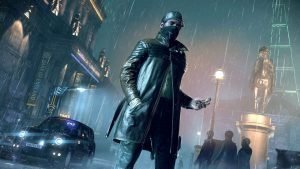 I enjoyed Bloodline and think it’s better than the main game, but I don’t blame any players who choose to think this is a money sink. Even playing as Aiden and Wrench for most of the game has the downside of them being overpowered compared to other operatives. I also wish I had access to Marcus Halloway, Raymond Kenny, Sitara, and Jordi. If you’re going to sell us previous protagonists, then go all out.
I enjoyed Bloodline and think it’s better than the main game, but I don’t blame any players who choose to think this is a money sink. Even playing as Aiden and Wrench for most of the game has the downside of them being overpowered compared to other operatives. I also wish I had access to Marcus Halloway, Raymond Kenny, Sitara, and Jordi. If you’re going to sell us previous protagonists, then go all out.
Watch_Dogs: Legion is a game that suffers for feeling like a stripped-down version of the previous games. The Recruitment system has its benefits but hurts the narrative and atmosphere of the game. The best way to play the game is also far more expensive than it should be. On the other hand, I really liked their dystopian vision of Great Britain and feel like the baddies were worth opposing for forty hours. The game is probably worth a skip if you don’t buy the Wrench and Aiden characters, though.
Play Watch_Dogs: Legion
The post REVIEW: Watch_Dogs Legion appeared first on Grimdark Magazine.
August 22, 2021
Let the Characters Take the Wheel
Every now and then (eerily it’s often around the time of a book launch) I’m asked a question that boils down to “What Comes First, Plot or Character?”
The answer – at least for me – is plot. Always, always, always plot. After all, without a plot, even the best characters in the world are going to end up sitting around talking about which of them left the fridge door open last night, what the colour green might taste like or whether hemlines should be up or down this year (the hem of a robe being a very serious business). That’s not to say such conversations can’t – or don’t – have value. It’s just that if they go on and on to the exclusion of all else, you get can largely the same effect from listening to a pair of drunks on a late night bus.
But here’s the thing: when I say “plot”, I mean it in the barest of bare bones kinda way. You know, a sort of “MacGuffin A is used by Protagonist B to defeat Antagonist C” structure. Often with the addendum of “using method D and after enduring plot twist E”.
Where does that plot come from? For me – and let’s be honest, for all of us – it’s an amalgam of other stories we’ve consumed over the years. That film I loved, the book I hated but wanted to love, and so on. Something I want to imitate or improve. Something that’s fun. Something that we hope might speak to other people. Doesn’t matter, really, because it’s not going to look anything like the source of inspiration once it’s done.
Because after I’ve taken that simple step of settling on a plot, it’s character all the way.
It starts with the protagonist or the antagonist, and what makes them someone I care about. And I absolutely have to care about them, otherwise what hope is there for the reader? What is the thing that makes that character cool? That makes them someone you can admire, openly or otherwise?
Their goals can be part of that, but it’s never so much about what it is they want as what they’ll do to get it… or more precisely what they won’t do. That line between yes and no is where heroes, villains and everything in between truly come alive, because it forces choices and consequences. Stories have to be larger than life, so any fork in the road has to matter – has to have a price, even if that price is no more complicated than the character’s moral hinterland being left in tatters.
Once I’ve got either the antagonist or the protagonist sorted, I can turn my attention to the other, starting with why they’re in opposition. This can be the obvious route – a Dark Lord versus a Chosen One
versus a Chosen One – but I personally prefer things to be a bit more flexible. A Dark Lord
– but I personally prefer things to be a bit more flexible. A Dark Lord versus a Chosen One
versus a Chosen One can really only close out one of two ways, depending on whether you’re going for the feelgood or downer endings, but Dark Lord
can really only close out one of two ways, depending on whether you’re going for the feelgood or downer endings, but Dark Lord versus Ordinary Guy (or Gal) on a Bad Day
versus Ordinary Guy (or Gal) on a Bad Day can end up just about anywhere.
can end up just about anywhere.
This is where the lines between yes and no really start to kick in, because at the heart of it all, either my protagonist, my antagonist – or both – are prepared (or driven) to do something that the other won’t. It doesn’t even have to be an objectively large difference – it just has to be significant to the characters.
 (While there’s a lot of other stuff going on in the Legacy Trilogy – and plenty of antagonists and protagonists lurking in the wings – the story turns on the conflicts and concords between Josiri Trelan and Viktor Akadra. Though not a typical adversarial relationship, the two are at loggerheads so often simply because Viktor is prepared to do things the Josiri won’t, and vice versa. The sparks fly when they come into conflict because they’re imperfect reflections, rather than complete opposites. The same is true of the other antagonistic pairings, from outright hero/villain matchups to squabbling family.)
(While there’s a lot of other stuff going on in the Legacy Trilogy – and plenty of antagonists and protagonists lurking in the wings – the story turns on the conflicts and concords between Josiri Trelan and Viktor Akadra. Though not a typical adversarial relationship, the two are at loggerheads so often simply because Viktor is prepared to do things the Josiri won’t, and vice versa. The sparks fly when they come into conflict because they’re imperfect reflections, rather than complete opposites. The same is true of the other antagonistic pairings, from outright hero/villain matchups to squabbling family.)
Once I’ve got my antagonist and protagonist sorted, it’s time to look at the friends, enemies and lovers who make them who they are. And then the friends, enemies and lovers who make them who they are. This could mean a detailed, blow-by-blow account of personality and history, a handful of character traits or a sneaky “a bit like Character X from Story Y”. But always, always, always at the heart of it are the two core questions: what do they want, and what lines won’t they cross?
That done, all that remains is to set the protagonist off on his or her journey and throw these other characters onto the path. I don’t even mind that much about the who, what and when (although I will occasionally bash two of my literary action figures together just because it’ll make for a nice noise). I already know these people and how they’ll react to each other… and more importantly, to each other’s goals.
This is where the magic happens – where the single vector of MacGuffin A, Protagonist B, Antagonist C is raised to the Nth and becomes a fractal landscape bursting with possibility. Every character weasels their way into being the protagonist of their own little corner of the story, and someone else’s antagonist to boot. Sometimes they’re aware of it, and fight like lions to stay there. Sometimes they’re just passing through while the real conflict gathers pace. Sometimes they know exactly what they’re doing, and sometimes it’s just for kicks.
It doesn’t matter, because it’s a hell of a ride. And, of course, all the characters are changing all the time, forging new friendships, making new enemies, failing upwards or tumbling downwards. That’s where the story comes from, and I wouldn’t have it any other way.
Plot is what happens. It’s a Wikipedia entry.
The characters are the reason it happens. They’re the story.
[Ed. The Legacy trilogy is one of my favourite book series to date, filled with brilliant characters and conflict. You can check out our reviews for Legacy of Ash, Legacy of Steel, and Legacy of Light on the GdM blog. Ready to jump into book 3? Order below!]
Read Matthew Ward’s brilliant characters in Legacy of Light
The post Let the Characters Take the Wheel appeared first on Grimdark Magazine.
August 21, 2021
REVIEW: The Immorality Clause by Brian Parker
The Immortality Clause by Brian Parker is the first book of his Easytown novels. The series takes place in the not-so-distant future. AI, cybernetics, androids, genetic engineering and virtual reality have all become common place with humanity having discovered ways to turn them all to sex. Yes, New Orleans is once more the party city of America and the debauchery is a source of income for crooked technophiles that cater to the darkest whims of society.
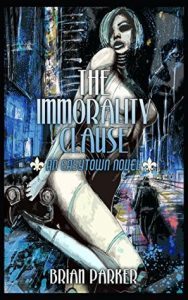 The premise is Detective Zach Forrest has Easytown as his beat. Easytown is the Red Light District of the future New Orleans where prostitution is legal as is most of these technological vices like android sex or VR fantasies. As a cop, Zach must abide by the titular “Immorality Clause” that will get him fired if he has sex with an android. Moral busy body-ness and hypocrisy in the future being alive and well. This wouldn’t normally be a problem for Zach, who has a disdain for androids, but a chance encounter leads him to falling for a girl who may not actually be a person as he defines them. Then the murders start happening and Zach is neck deep in it.
The premise is Detective Zach Forrest has Easytown as his beat. Easytown is the Red Light District of the future New Orleans where prostitution is legal as is most of these technological vices like android sex or VR fantasies. As a cop, Zach must abide by the titular “Immorality Clause” that will get him fired if he has sex with an android. Moral busy body-ness and hypocrisy in the future being alive and well. This wouldn’t normally be a problem for Zach, who has a disdain for androids, but a chance encounter leads him to falling for a girl who may not actually be a person as he defines them. Then the murders start happening and Zach is neck deep in it.
The Immorality Clause draws heavily from the ideas in Blade Runner but envisions a less fascist and more casually exploitative future. Humans aren’t afraid of being replaced by androids and there’s some ambiguity over whether they are sentient or not. Zach has a Siri-like personal assistant named Andi that seems to be completely sentient but is eager and willing to help him with all his day-to-day activities so he doesn’t bother to question the power imbalance.
I rather like this view of a cyberpunk future because combining the kind of wet, humid, and organic feel of New Orleans (a very old traditional city) with the bleeding edge of technology is an interesting idea. New Orleans is Catholic and Old World but also has a history of racial strife as well as party tourism. It results in a surprisingly believable environment that combines True Detective with Ridley Scott’s interpretation of Phillip K. Dick’s novel.
Despite its focus on sex and murder, The Immorality Clause could easily be a program on network television and is more NCIS: New Orleans 2066 than HBO prestige series. There’s a light and humorous tone even as Zach is investigating the horrible crimes going on around him. The story stays well within the confines of a PG-13 crime drama where most of the violence and seediness remains off-camera.
Zach Forrest is a likable yet flawed protagonist who sort of bumbles his way through the case not through a passionate desire for justice but not knowing when to take a hint. His one saving grace is that he really doesn’t like to be told what to do and when it would be easier to drop matters, doubles down on them as well. I liked his relationship to Paxton Amora and felt it was interesting just from the perspective of whether any of the feelings were “real” or programmed in.
In conclusion, this is a great cyberpunk detective novel and merges the noir as well as scifi genres seamlessly. If you like detective stories or near-future scifi then this is likely for you. I also recommend picking up the audiobook as the narration by Daniel Penz is top notch.
Read The Immorality Clause by Brian Parker
The post REVIEW: The Immorality Clause by Brian Parker appeared first on Grimdark Magazine.
August 20, 2021
Aussie stouts and book pairings to warm your grimdark heart
There are few better ways to spend a winter’s afternoon than opening up a grimdark book next to an Australian royal imperial stout (barrel aged if you can get it!), kicking your feet up on the balcony in the sun, and losing yourself for a few hours. Like our favourite grimdark books, stouts in Australia have come a long way in the last decade, and while we’re not quite at US levels of stout awesomeness, the gap has narrowed by a significant margin.
For me, a book and a beer (as you’ll know if you follow our Instagram page) is one of the simple pleasures in life. So here are five recommendations for both book and beer that I know you’ll love.
Before you read on: if alcohol is a problem for you, please both seek help with an organisation like DrinkWise, and please click here to go to another just-as-awesome book recommendation post without alcohol included.
Old Money Barrel Aged Stout and The Court of Broken Knives Thick and dark, with many layers in flavour that develop as it warms, Sydney-based Stockade Brewing’s Old Money Barrel Aged Imperial Stout is a perfect sipper for an afternoon in the winter sun. Both the name and forward flavours of spices and dried fruit put me right in the mood for reading about the falling, once-great empire of Sorlost. And with the pace of this book, you may very well find yourself needing a second bottle after realising the afternoon has disappeared and the stars are out.
Thick and dark, with many layers in flavour that develop as it warms, Sydney-based Stockade Brewing’s Old Money Barrel Aged Imperial Stout is a perfect sipper for an afternoon in the winter sun. Both the name and forward flavours of spices and dried fruit put me right in the mood for reading about the falling, once-great empire of Sorlost. And with the pace of this book, you may very well find yourself needing a second bottle after realising the afternoon has disappeared and the stars are out.
If you haven’t yet read The Court of Broken Knives by Anna Smith Spark, get on it! You can find our review here.
3Ravens Barrel Aged Peated Imperial Oatmeal Stout and The Poppy War For an 18 percenter like 3Ravens’ Barrel Aged Peated Imperial Oatmeal Stout you need something just as heavy. And with a trigger warnings list that covers off, “self-harm, suicide, violent rape, sexual assault, murder, massacres, brutalization, mutilation, torture, substance abuse, abuse, emotional abuse, physical abuse, relationship abuse, human experimentation, chemical warfare, and genocide” you know you’ve found it in The Poppy War by R.F. Kuang. A fantasy novel inspired by the darkest chapters of China’s twentieth century, The Poppy War is an enjoyable, compelling read with great action, emotional impact, and an awesome magic system.
For an 18 percenter like 3Ravens’ Barrel Aged Peated Imperial Oatmeal Stout you need something just as heavy. And with a trigger warnings list that covers off, “self-harm, suicide, violent rape, sexual assault, murder, massacres, brutalization, mutilation, torture, substance abuse, abuse, emotional abuse, physical abuse, relationship abuse, human experimentation, chemical warfare, and genocide” you know you’ve found it in The Poppy War by R.F. Kuang. A fantasy novel inspired by the darkest chapters of China’s twentieth century, The Poppy War is an enjoyable, compelling read with great action, emotional impact, and an awesome magic system.
Make sure you check out our review of The Poppy War.
Bacchus Brewing Islay Reserve and Prince of Thorns For a book like Prince of Thorns by Mark Lawrence, you need something as smoky and peaty as the hole this book will punch in your heart. Each year Bacchus Brewing‘s Islay Reserve limited releases sell out in minutes, and for good reason. It has incredible depth and length of flavour, and that smokiness is an absolute must for peatier scotch fans. While technically a barley wine (I’ve unapologetically betrayed you here, like Jorg would), out of the beers I personally cellar, the Islay Reserve is something I’ll hold on to until I’m celebrating something significant or reading something magnificent … like Prince of Thorns.
For a book like Prince of Thorns by Mark Lawrence, you need something as smoky and peaty as the hole this book will punch in your heart. Each year Bacchus Brewing‘s Islay Reserve limited releases sell out in minutes, and for good reason. It has incredible depth and length of flavour, and that smokiness is an absolute must for peatier scotch fans. While technically a barley wine (I’ve unapologetically betrayed you here, like Jorg would), out of the beers I personally cellar, the Islay Reserve is something I’ll hold on to until I’m celebrating something significant or reading something magnificent … like Prince of Thorns.
If you’ve never heard of Prince of Thorns before, click here, buy it, read it, thank me later.
Boatrocker Fat Santa and A Crown for Cold Silver Fun and different, with plenty of flavours to get your head around, Boatrocker’s Fat Santa is a perfect match for a book with such a diverse and fun cast (who obviously get thrown into the grinder). A Crown for Cold Silver is a slow burn start, a well developed middle with plenty of POV cross interactions and pre-book world building hints, laughs, and then a barnstorming ending with plenty of vicious, bleak and anticipation-building finishes. I honestly couldn’t think of a better beer to match, with Buffalo Trace bourbon barrel, dark roast whole coffee beans, Madagascan vanilla pods, tonka beans, and bourbon and American oak characters.
Fun and different, with plenty of flavours to get your head around, Boatrocker’s Fat Santa is a perfect match for a book with such a diverse and fun cast (who obviously get thrown into the grinder). A Crown for Cold Silver is a slow burn start, a well developed middle with plenty of POV cross interactions and pre-book world building hints, laughs, and then a barnstorming ending with plenty of vicious, bleak and anticipation-building finishes. I honestly couldn’t think of a better beer to match, with Buffalo Trace bourbon barrel, dark roast whole coffee beans, Madagascan vanilla pods, tonka beans, and bourbon and American oak characters.
Grab yourself a copy of A Crown for Cold Silver after reading our review.
Range Brewing Canadian Tuxedo and Beyond Redemption Now, this pairing isn’t so much about a linking of flavours, but more simply because I love this royal imperial stout from Brisbane-based Range Brewing about as much as I love Canadian author Michael R. Fletcher and his debut Beyond Redemption. It’s highly likely the author is sick of me spruiking his debut release (I can hear him shouting at me from the other side of the world, “I HAVE OTHER BOOKS, EH”) but it just fecks me off this book wasn’t a bigger deal. To be honest, there are some scenes in this book where putting a liquid of any sort into your mouth probably isn’t going to sit well with you, but if you can stomach it, this is the right beer.
Now, this pairing isn’t so much about a linking of flavours, but more simply because I love this royal imperial stout from Brisbane-based Range Brewing about as much as I love Canadian author Michael R. Fletcher and his debut Beyond Redemption. It’s highly likely the author is sick of me spruiking his debut release (I can hear him shouting at me from the other side of the world, “I HAVE OTHER BOOKS, EH”) but it just fecks me off this book wasn’t a bigger deal. To be honest, there are some scenes in this book where putting a liquid of any sort into your mouth probably isn’t going to sit well with you, but if you can stomach it, this is the right beer.
Check out Beyond Redemption by Michael R. Fletcher.
(Ed. All photos taken in my kitchen. Massive apologies to the brweries for my atricious photography skills. They look much better sitting in front you you, I promise!)
The post Aussie stouts and book pairings to warm your grimdark heart appeared first on Grimdark Magazine.
August 19, 2021
REVIEW: Assassin by Andy Peloquin
Assassin by Andy Peloquin is the revised version of Darkblade Assassin, which was a indie dark fantasy novel released in 2018. This new version of the book is half-again in size of the original book and greatly expands the original story to include more plots, deeper characterization, and a greater use of the setting’s mythology. It’s still available on Kindle Unlimited and is 757 pages, which I view as two decent sized fantasy novels available for close to nothing. But is it any good? Read on and find out.
 The premise is that there exists a port city, Voramis, that is utterly under the control of a ruthless gang called the Bloody Hand. The only person not under their control is the mysterious Hunter. The Hunter exterminates the rich, powerful, and corrupt of the city with equal fury. He has few contracts that require him to kill the innocent because there are so few of them in the city that he assumes everyone is hiding some sort of horrific secret.
The premise is that there exists a port city, Voramis, that is utterly under the control of a ruthless gang called the Bloody Hand. The only person not under their control is the mysterious Hunter. The Hunter exterminates the rich, powerful, and corrupt of the city with equal fury. He has few contracts that require him to kill the innocent because there are so few of them in the city that he assumes everyone is hiding some sort of horrific secret.
The Hunter is almost unstoppable when he he is unleashed due to possessing a magical dagger named Soulhunger. It provides him power and healing in exchange for souls. However, the Hunter is seemingly in denial that this is anything stranger as he considers the ideas of gods or demons to be hogwash. Indeed, he doesn’t seem to make any sort of connection to them being real or any magical phenomenon despite his dagger being a large evidence of this being the case. After all, souls are something commonly associated with all three.
Either way, the Hunter soon finds himself locking horns with the Bloody Hand and it is a conflict that brings him into contact with the Beggar Priests. The Hunter has nothing but disdain for religion, especially when he is asked to hunt down and eliminate demons. Unfortunately, this is not something he can ignore as demons are very real in Voramis and intimately tied to his background. Saying more would be spoilers but it is a solid dark fantasy story with lots and twists and turns before its conclusion.
Andy Peloquin is one of my favorite indie writers in that he manages to tell stories of epic adventure and bloody revenge across multiple settings. I loved his Cerberus and Queen of the Night Guild books, so I very much enjoyed this. I will say that it is my least favorite of the three but that’s merely because I enjoyed their protagonists more. The Hunter’s disdain for religion and skepticism becomes annoying after awhile, especially when he’s repeatedly confronted with the reality of the supernatural. He’s also somewhat needlessly hostile to everyone he meets, though I suppose that’s to be expected of a man with a bodycount in four figures.
Still, this book is full of action and enjoyable scenes that made it a lengthy but fun read. It reminded me of some of my favorite low fantasy series with the majority of focus on what a cess pit Voramis is. It’s one of those delightful wretched hives like Dragon Age’s Kirkwall or Mos Eisley. Indeed, it comes as a genuine surprise when the Hunter meets people who aren’t complete scumbags. The climax is a little too drawn out but the villains are so hateable that I relished when we finally started knocking them off. Either way, I feel like this is a book worth checking out.
Read Assassin by Andy Peloquin
The post REVIEW: Assassin by Andy Peloquin appeared first on Grimdark Magazine.



